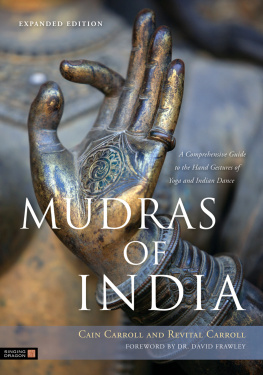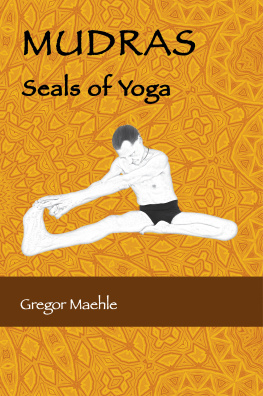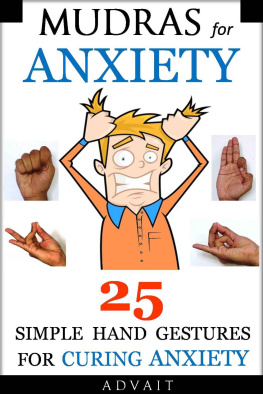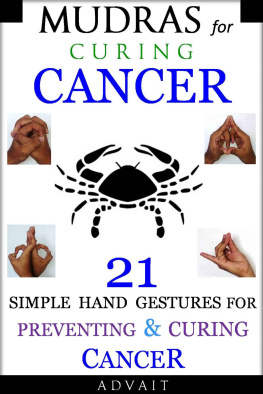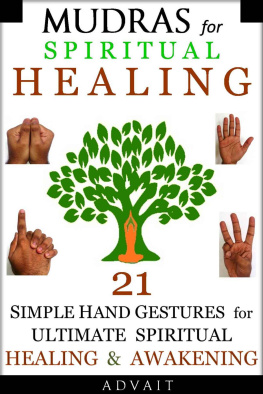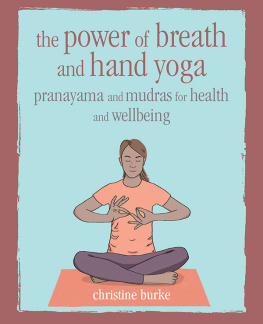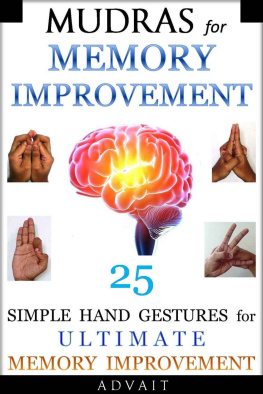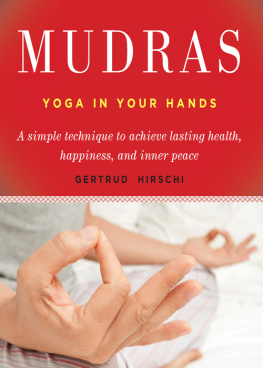A BOUT THE A UTHORS
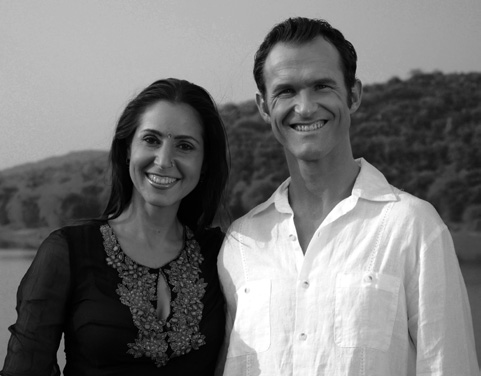
Cain Carroll
Cain Carroll teaches yoga, qigong, meditation, and self-healing worldwide. He has trained extensively under the guidance of Daoist, Buddhist, and Indian yoga masters. His journeys have taken him to remote areas of India, China, Nepal, Tibet, Thailand, and South America, where he received private instruction in numerous systems of practice. Cain is co-author of Partner Yoga: Making Contact for Physical, Emotional and Spiritual Growth (Rodale 2000) and creator of three self-healing DVDs: Pain-Free Joints , Heal Neck and Shoulder Pain , and Digestive Power . He served for two years as the Director of Yoga Teacher Training at Southwest Institute of Healing Arts (Tempe, AZ), and four years as Yoga Director and co-owner of Yoga Shala (Prescott, AZ). Please visit www.caincarroll.com for more information.
Revital Carroll
Native to the land of Israel, Revital has been dedicated to the study of Indian spiritual arts since childhood. Intensive study and practice of yoga and meditation in the Himalayas led her to discover her passion for Indian dance where she finds the sensual and the spiritual expressing as one. She is the creator of three instructional DVDs: Temple Goddess Workout , Odissi Dance Foundations , and Odissi Dance Spins and Choreography , and her articles about Classical Indian Dance and yoga appeared in numerous magazines. Revital offers classes, workshops and performances worldwide. She was the co-owner of Yoga Shala in Prescott, AZ, and the director of several yoga programs in North California. She draws her inspiration from the elements of nature, the wisdom of her own body, and the rich spiritual heritage of ancient India. She currently lives and teaches in the bay area of San Francisco. Visit www.shaktibhakti.com for more information.
A CKNOWLEDGMENTS
We are grateful to all the yogis and dancers who have carried forth the rich tradition of hand mudras throughout the centuries, and to all of the talented and inspiring people who helped us bring this project to fruition. Thank you to Reed Rahn for his magic with the camera during our Phoenix photo shoots, to Phil Timper for all his work rendering the mudra images (and Nancy Timper for not breaking the bank), to Dilip Kumar Dhirsamant for his endurance and patience during our long photo shoot in Bhubaneswar, to Sanskrit scholar, Nicolai Bachman, for his editorial suggestions and rendering of the Devanagari and transliteration of the mudra names, to Dr. Mandakranta Bose for her wise counsel and editorial suggestions, and to our publisher, Jessica Kingsley, for her sincere interest in seeing this book come to life, and the whole team at Singing Dragon for their patience, flexibility, and professionalism.
From Cain
I am deeply grateful to all of my teachers, and the generations of lineage masters who came before, who have inspired and informed my practice of mudras and the many other dimensions of internal cultivation: Baba Hari Das, Satjivan Singh, Ari Singh, Yogi Das, Dr. Yogi Vikeshanand, Banambar Baba, Master Zhongxian Wu, Liu Shan, Daoist Yogi Ramkohea, Dr. Matt Schlechten, and Sun Yogi Umashankar. I offer my heartfelt gratitude to all of my family and friends who lift me up with their unending support, to my friend and colleague, Laraine Herring, for all her helpful writing tips, playful encouragement, and mostly for being a living example of a writing warrior, and to all of my students who continue to inspire me with their sincere desire to learn and practice the yogic arts. Special thanks to my loving wife and coauthor, Revital Carroll, for being my trusted partner in this book project and in our everyday life together.
From Revital
I extend my heartfelt gratitude to all my teachers who took the time to share their vast knowledge of hand mudras with me. I extend special thanks to my first Odissi Dance teacher, the late Guru Gangadhar Pradhan, and his senior disciple Sri Lingaraj Swain, for initially introducing me to the art of dance mudras and their proper usage, and for instilling in me the passion to always aspire to expand my knowledge and remain an eternal student. My deepest gratitude goes to Guru Bichitrananda Swain and Sri Pabhitra Kumar Pradhan for their willingness to engage in conversation about the subtle meanings of the numerous mudras applications. I am grateful to my dance teachers: Sri Yudishtir Nayak, Smt. Sujata Mohapatra, Guru Rathikant Mohapatra, and Smt. Niharika Mohanty, from whom I am continuously learning more about the form, grace, and proper usage of hand mudras in Classical Indian Dance. I am filled with infinite appreciation to Guru Kelucharan Mohapatra, whom I never had the grace of meeting in person, but who influences my dance journey multifold through all of my teachers, and through the Odissi Research Institute, with its immense contribution to the study of hand gestures. I thank all of my yoga and meditation teachers for stoking the fire of spiritual aspiration within me, and for continuing to inspire me to follow my intuition, passion, and devotion as I deepen my practice. My special thanks to Clive Sheridan, my first teacher of Tantric hand mudras, whom I met while wandering through India in the early 1990s. I offer my sincere appreciation to Kali Ray for sharing her unique and inspirational relationship with the practice of hand mudras, and intriguing me to deepen my intuitive relation to the power in my hands. I thank all of my students, colleagues, and friends for encouraging and inspiring me to continue to learn and share my knowledge with them. And last but not least, I thank my husband, Cain Carroll, for his vision, unwavering support and encouragement, and for believing in me.
A PPENDIX A
Energy Anatomy
The Seven Chakras of Indian Tantric Yoga
Muladhara Chakra mula (base or root), adhara (support)
Location: Perineum, below genitals, above anus, base of spine
Element: Earth
Number of Petals: 4
Elemental Color: Shining yellow
Ruling Planet: Mars
Governs: Feet, legs, anus, and elimination
Positive Attributes: Stability, loyalty
Negative Attributes: Stubbornness, heavy mindedness
Svadhishthana Chakra sva (self), adhisthana (dwelling place)
Location: Genital region
Element: Water
Number of Petals: 6
Elemental Color: Light blue
Ruling Planet: Mercury
Governs: Reproductive system, power to create
Positive Attributes: Flexibility, openness, intuitiveness
Negative Attributes: Ungrounded-ness, unconscious leakage of sexual energy
Manipura Chakra mani (jewel), pura (filled with or city)
Location: Behind navel, toward spine
Element: Fire
Number of Petals: 10
Elemental Color: Sunrise red
Ruling Planet: Sun
Governs: Digestion, assimilation
Positive Attributes: Zest for life, vitality, self-control
Negative Attributes: Ruthlessness, abuse of power, self-abuse
Anahata Chakra (un-struck sound)
Location: Heart region of the spine
Element: Air
Number of Petals: 12
Elemental Color: Smoky grey
Ruling Planet: Venus
Governs: Heart, diaphragm, lungs, arms, and hands
Positive Attributes: Devotion, love, compassion
Negative Attributes: Attachment, rampant emotions, hate
Vishudha Chakra (pure)
Location: Throat area
Element: Ether/Space
Number of Petals: 16
Elemental Color: White (like the full moon)
Ruling Planet: Jupiter
Governs: Speech, thyroid, parathyroid
Positive Attributes: Expansiveness, silence, deep calm
Negative Attributes: Spacey-ness, boredom, restlessness
Ajna Chakra (enhanced knowledge)
Location: Point between eyebrows, base of skull
Next page
